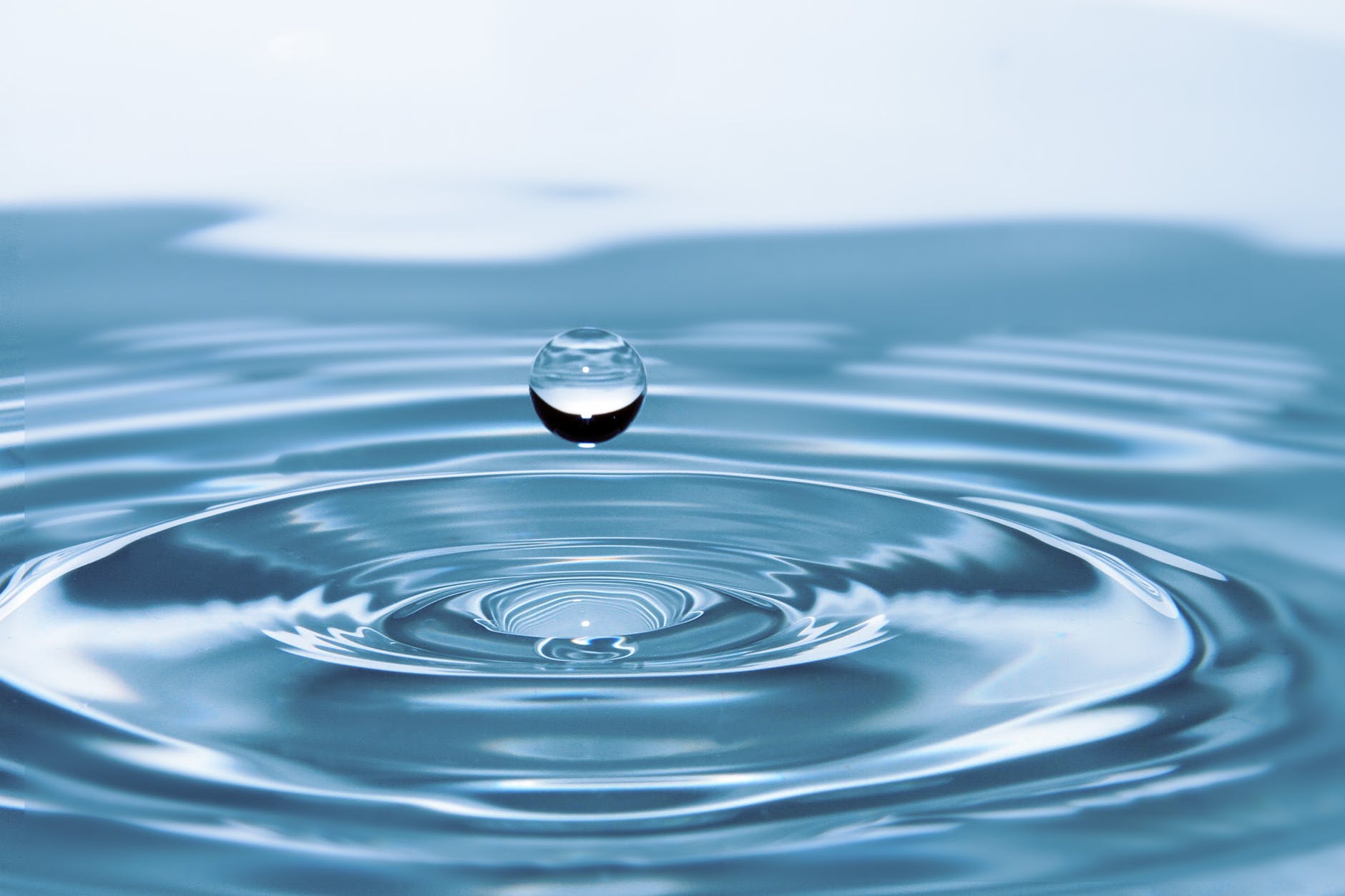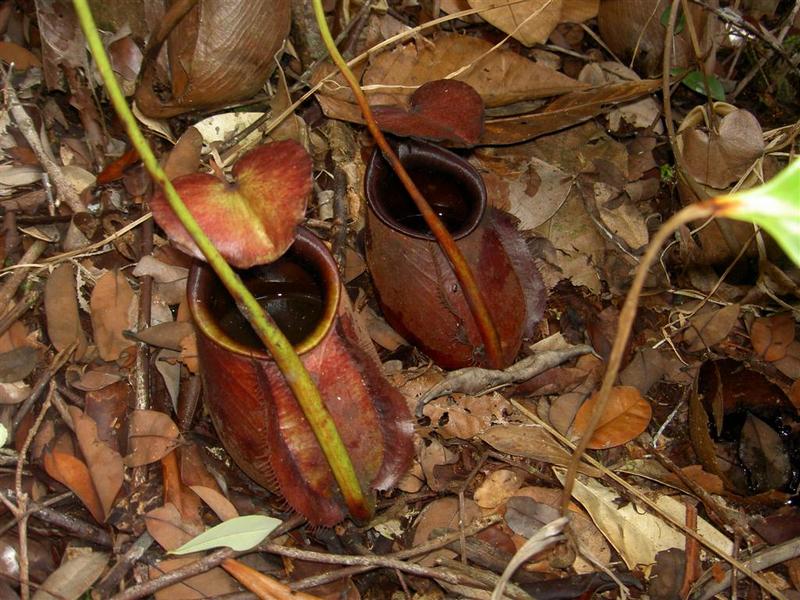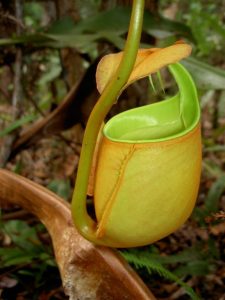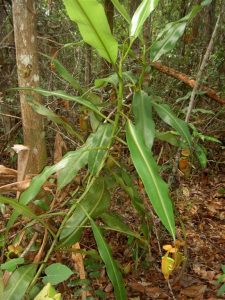La Nepenthes bicalcarata it is a very curious carnivorous plant: it does not have mouth-shaped traps like the Venus flytrap, but rather small jugs filled with liquid covered with very short and slippery hairs.
In addition, it develops its own leaves, let's say true, something that is not very common in this type of plant beings since most of what it has done is precisely turn its leaves into traps.
Origin and characteristics of Nepenthes bicalcarata
- Image - Wikimedia / Hans Breuer
- Image - Wikimedia / Hans Breuer
It is a precious carnivorous plant, known as the tusked pitcher plant, endemic to northwestern Borneo, where we will find it climbing up to 20 meters in the canopy of the tropical forest. The stem is cylindrical and measures up to 3,5 centimeters in diameter, thus being the thickest that a Nepenthes can have today.
The leaves are lanceolate, petiolate and somewhat leathery, measuring up to 80 centimeters long by 12 centimeters wide. The midrib is very marked, and is yellowish-green in color. Their traps can have a volume of more than a liter, and they grow up to 25 centimeters high by 16 centimeters wide.
Its flowers are grouped in paniculate inflorescences with a peduncle up to 40 centimeters long and a rachis up to 100 centimeters long. There are female, which are the shortest, and male.
As a method of climbing, develops hollow, swollen tendrils up to 60 centimeters long by 8 millimeters wide.
What are the care you need?
If you want to have a copy, we recommend that you take into account the following tips to keep it healthy for many years:
Location
The tusked pitcher plant is a carnivore that must always be protected from direct sunlight, otherwise its leaves will burn and it will not survive. That is why it is important that, if it is kept outside, it is placed for example under other larger plants, or protected by a wall.
Inside the house, on the other hand, it must be in a room in which there is a lot of natural light, so that it can perform its functions normally, and away from both cold and hot air currents.
Earth
It must be kept in a plastic pot with drainage holes, filled with a mixture of peat moss and perlite in equal parts.. You can buy it from here.
Do not use black peat, mulch or others: the roots would suffer damage as they are not used to growing on this type of land.
Irrigation

Uncontaminated, distilled or osmosis rainwater must be used. Water moderately, which in this case is an average of 4 times a week in summer and somewhat less the rest of the year.
To do this, you can water by filling the plate under the pot, or by directly moistening the substrate.
Subscriber
It should never be paid. Manures and fertilizers burn the root system.
It must be borne in mind that carnivores are what they are because they feed on the body of the insects they trap, and therefore they do not need more nutrients than they digest.
Transplant
La Nepenthes bicalcarata you have to change the pot very few times. In general, with 2 or 3 transplants throughout your life will be more than enough, because your root system does not need much space to grow.
Do it in spring, when the minimum temperature is at least 15 degrees Celsius, and only if roots grow out of the drainage holes, or if you see that it has already occupied the entire container.
Pests
It is quite resistant, but it can be affected by aphids and mealybugs if the environment is very dry and warm. These pests they must be removed with water and mild soap, since the use of commercial insecticides damages its leaves.
Management
If it is watered excessively, or if the environment is very humid, fungi such as phytophthora will rot their roots and / or leaves. So, you have to control the irrigation a lot and, in case you see any black, brown or even white stain, cut your losses with scissors previously disinfected with pharmacy alcohol.
Multiplication
La Nepenthes bicalcarata multiplies by seeds and cuttings in spring, and air layering in summer. Let's know how to do it:
Seeds
The seeds are sown as far apart as possible in a plastic pot with drainage holes filled with a mixture of equal parts white peat and perlite.
It must be kept at a temperature of about 20ºC. A) Yes will germinate in a month and a half approx.
Cuttings
A piece of the upper part of the stem has to be cut, and planted in a plastic pot with drainage holes with blond peat and perlite mixed in equal parts. Keeping the temperature at about 25ºC and the substrate moist, will root after a couple of weeks.
Aerial layering
You have to follow this step by step:
- First, a circular cut is made, very carefully, around a long stem.
- Then another circular cut is made lower down.
- Then, the bark is removed between the two cuts, and fungicide and rooting hormones are applied.
- Finally, it is surrounded with sphagnum fibers previously moistened with distilled water, and protected with transparent plastic.
In about 2-3 months you will have a rooted layer, and you can cut it and plant it in an individual pot. Don't forget to treat the cuts with fungicide.
Rusticity
Due to its origin, it is a tropical plant that does not resist cold or frost. The minimum temperature it supports is 5ºC, although it is better not to drop below 15ºC.

Image - Wikimedia / Hans Breuer
What did you think of Nepenthes bicalcarata?


Some care is wrong, for example this nepenthe is ultra low lan, and does not support low temperatures, if you put it at 15 degrees it will die, in my winter they grow slowly in a greenhouse I have 18 degrees at least and still not They like it and they turn a little pale, so it would be better above 20 degrees.